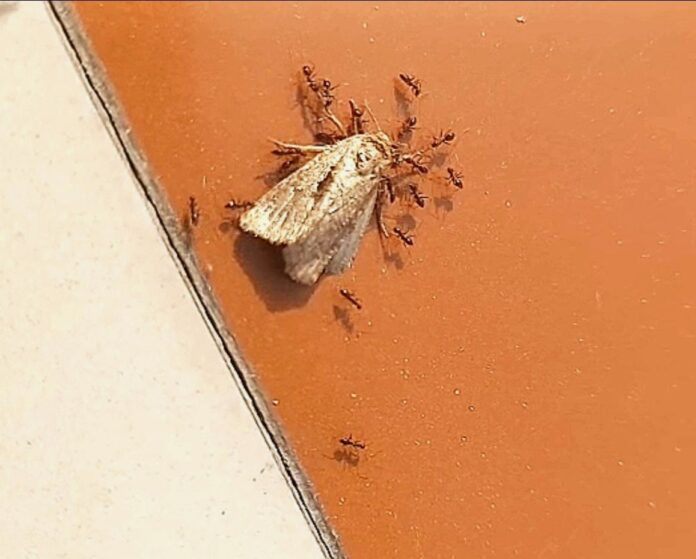The mechanism of ‘Co-operative Transport’ of food and other objects by Ants
Finding, acquiring and consuming food are inherent activities that all living organisms have to undertake for survival and propagation of species. The search for food often requires that the food item is consumed immediately or transported to a safe place for future consumption. This quick removal helps in avoiding interspecific competition. Transporting found food items is therefore an important part of foraging.
In this clip we observed a Moth (Clothes Moth- Tineola bisselliella) being transported collectively by team of small black ants. It is only later that we realised that it was mobbed and was alive. Right or wrong, I did rescue it and put it away from the ants but what interested me was the mechanism of this collective transport.
Apart from humans, Ants are also regularly known to practice large scale co-operative transport involving two or more individuals simultaneously moving an object.
Cooperative transport is either the non-coordinated type where the movement is slow, poorly coordinated with frequent deadlocks or the coordinated type where transport is achieved either through encircling cooperative transport or through the forward-facing coordinated transport. Both the types of coordinated transport systems are fast, well-coordinated and with few dead locks.
During encircling cooperative transport, which this team of ants as in the clip is wanting to achieve, the ants at the front of the object lift and pull or drag the object while moving backwards. Ants at the rear of the object, lift it and walk forwards and ants at the side lift or drag and walk sideways. This requires team work and the ants work as a team.
The forward facing coordinated transport involves a comparatively larger worker straddling and carrying an object from the front while facing forward and one or two workers help to lift at the back also facing forward.
In the coordinated systems of transport, teams may be constituted and deployed by specialized recruitment’s from amongst workers.
As a food item is discovered by a scout, it assesses whether cooperative transport is required. If yes, recruitment is initiated by the scout and the number of ants deployed is adjusted to the size of the object. As a mater of principle, ants leave a team if their strength is greater than needed to move the object efficiently.
It has also been reported that if the scout, leading the team to the object, is removed the group disbands and foraging is abandoned.
When ants transport an item individually they lift and carry items facing forward but drag heavy items while facing backward. The same rules aften apply during cooperative transport. Ants first join the from of the item and then the back.
Groups of ants are also capable of rotating an item to achieve minimum resistance to movement.
Whether or not ants communicate during collective transport is not well known. In some experiments it has been observed that ants may pool together the opinion of all group members to increase their navigational efficiency. The inaccuracy of each individual assessment is largely cancelled by the summing up of many opinions. The ‘Wisdom of the Crowd’ strategy which states that as long as each member makes an individual assessment of the available options, the accuracy of the group would increase with its size. This is preferred over the follow-the-leader approach. The wisdom of the crowd strategy requires that all ants are roughly informed about the nest position and pull in their preferred direction without taking into account the forces produced by other workers.
Cooperative transport of object in ants is not yet understood at its best. While transport of inanimate object is understood to a certain extent, mobbing and the transport of live objects may need more information.
©Srimaa Communication
Credits- Dr. Yashpal Singh, Mrs. Neena Singh, Mr. Manoj Kumar Yadav
